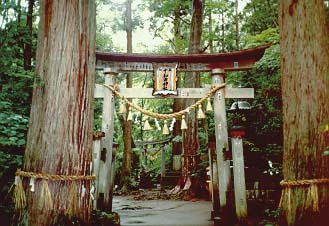

Shrines, Temples & Churches:
Buddhist clergy are more than
twice as numerous as Shinto clergy. New Religions, for their part, show
a much higher ratio of priests to members than traditional religions, because
most groups of this kind count lay leaders as clergy.
Shinto
Shinto has its origin in ancient indigenous traditions. It may be defined as an agglomeration of nature worship; tribal cult, hero worship, and reverence for the representatives of Amaterasu ( Sun Goddess ). An ordinary Shinto shrine is the domicile of a guardian deity or tutelar of the village, town, or prefecture. The Ise Grand Shrine (Ise Jingu), which enshrines Amaterasu Omikami or the Sun Goddess - founder of the Imperial House, is believed to guard the Japanese nation as do scores of shrines
The myth of the origin of the nation relates that in prehistoric times the Imperial government took the form of a theocracy. The belief that the Emperor was divine was sustained for many centuries. This belief was reinforced by the Meiji Government, which, in 1868, restored the Emperor to power, established a Department of Shrine Affairs, and nationalized Shrine Shinto in what came to be known as State Shinto.
Some advocates of Shinto, however, desired to propagate it as a religion and chose not to have their groups nationalized. The government subsequently placed them on an equal footing with other religions and classified them as Sect Shinto. Thirteen such sects were recognized by the end of the nineteenth century. Since the end of World War II, this figure has grown ten times through schism and the emergence of new bodies.
Buddhism
Buddhism came to Japan from India through China and Korea in 538 A.D. It gained Imperial patronage thanks to the efforts of Prince Shotoku, Regent from 593 to 628. Under his leadership, the Horyuji Temple was built as a center of learning. Subsequently the Six Schools of academic Buddhism--Sanron, Hosso, Jojutsu, Kusha, Ritsu, and Kegon--prospered at Nara and the Great Statue of Buddha at Nara was constructed to symbolize the authority of the Imperial government.
The arrival of Tendai and Shingon Buddhism in the ninth century marked the opening of a new age. These esoteric sects served the court aristocrats and contributed to the growth of the fine arts. They also helped foster the fusion of Buddhism and Shinto.
The Kamakura Period (1192-1333), an age of austerity and martial arts, saw the rise of Pure Land, True Pure Land, Zen, and Nichiren Buddhism. Unlike the founders of the sects of preceding eras, the founders of the Kamakura Sects put more emphasis on experience than on learning. These men and their disciples introduced Buddhism to farmers, fishermen. warriors, merchants. and artisans.
During the Tokugawa Period (1603-1867). Buddhist temples were used as national registration agencies and Buddhism lost much of its vitality amidst the material security which governmental control offered. In the century following the Meiji Restoration, Buddhist leaders gradually became aware that the traditionally accepted Chinese texts had substantially transformed the original teachings of Gautama, and this in turn stimulated research into original Buddhism through the Sanskrit and Pali texts. This effort, however, failed to reform the entrenched sectarianism.
With the end of World War II, powerful innovative movements gradually emerged. Unlike the traditional organizations, these stressed laymen's Buddhism and undertook political as well as social activities. Typical examples of these movements are the Sokagakkai and Rissho Kosei-kai
Christianity
Christianity was first introduced to Japan in 1549 by Jesuit missionary. St. Francis Xavier. It was an age of internal strife and commotion, and the new religion was welcomed those who sought new spiritual symbols as well as by those who hoped to get in touch with the West for its culture, advanced firearms, and trade. Upon the unification of the nation toward the end of the sixteenth century, however, those who secured hegemony over the nation suppressed all potential for further change, and out of their suspicion over the territorial designs of the Western nations and the fear that Christianity would have a disruptive effect on the established order they decided to ban the new religion.
In the middle of the nineteenth century, Japan was forced by the Western Powers to end its self-imposed seclusion and to tolerate Christianity in the name of religious freedom. Catholic missionaries from France and Protestant missionaries from the United States brought back the Christian Gospel to Japanese shores.
Japanese churches today are not devoid of the sectarianism and denominationalism of their sister churches in the West. But, unity above and beyond sectarian boundaries has characterized the major Protestant churches in Japan. Also, liaison between Catholic and Protestant churches has long been maintained. Christian churches in Japan are no longer "missionary churches," as most of them are self-supporting and have developed features of their own.
Miscellaneous Religions
Most of the organizations in this classification were founded by shamanistic personalities in the last or present century and grew rapidly after the end of World War II.
The oldest and by far the largest in respect of the number of churches, teachers; and members is Tenrikyo, founded in the middle of the nineteenth century by a female shaman, Miki Nakayama. Other organizations of this classification include Tensho Kotai Jingukyo, a group emphasizing ecstatic states; the PL Kyodan or Perfect Liberty association, a group advocating artistic creativity; Sekai Kyuseikyo, a group that promotes faith healing and agriculture without using fertilizers; and Seicho no le, the alleged synthesis of all the world's religions.
These religions are more concerned with the problems of this world than with those of life after death. Though often criticized for eclecticism, vulgarity, and magico-religiosity, they have activated the spiritual life of many people who had little to do with traditional religions.
******
Courtesy:
The International Society for Educational Information,
Inc., Tokyo
We want to thank the authors for this information.
 RETURN
TO HOMEPAGE
RETURN
TO HOMEPAGE